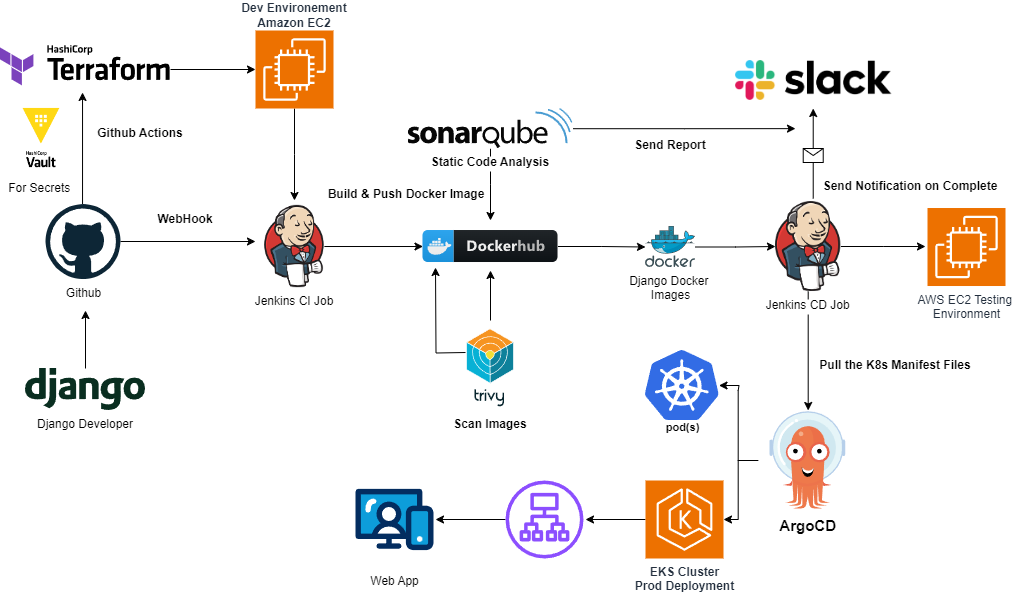MORU

Date
April 16th, 2025
Client
Individual
Services
Cloud Ops
DevSecOps
CI/CD Automation
Building a Modern DevSecOps Pipeline for Django Applications
The architecture diagram illustrates a comprehensive DevSecOps pipeline for Django web applications, showcasing how modern development practices integrate security, automation, and deployment across multiple environments. This well-structured workflow demonstrates a mature approach to software delivery that emphasizes both velocity and quality.
The Development Lifecycle Explained
At the heart of this architecture is a seamless flow from development to production that incorporates several key DevOps practices:
Source Control and CI/CD Initiation
The pipeline begins with Django developers committing code to GitHub, which serves as the central source code repository. GitHub Actions trigger the CI/CD process while HashiCorp Vault securely provides necessary secrets and credentials throughout the pipeline, ensuring sensitive information remains protected.
Automated Build and Security Scanning
When code is committed, a webhook triggers Jenkins to start the continuous integration process. The first Jenkins CI job builds the application and packages it as a Docker image, which is then pushed to DockerHub. Before deployment, the pipeline incorporates multiple security scanning tools:
- SonarQube performs static code analysis to identify code quality issues and security vulnerabilities
- Trivy scans the Docker containers for known vulnerabilities in both the application and its dependencies
This security-first approach helps identify potential issues early in the development cycle when they’re least expensive to fix.
Testing Environment Deployment
After security validation, a second Jenkins CD job provisions a testing environment on AWS EC2 instances. This environment closely mimics production, allowing for realistic integration and user acceptance testing. The job also sends notifications to Slack upon completion, keeping the team informed of deployment status.
Production Deployment with Kubernetes
For production deployment, the architecture leverages:
- ArgoCD for GitOps-based Kubernetes deployment, pulling Kubernetes manifest files from the repository
- Amazon EKS (Elastic Kubernetes Service) as the production container orchestration platform
This approach ensures that infrastructure is treated as code and that the deployed environment precisely matches what was defined in the repository.
Key Benefits of This Architecture
This architecture delivers several significant advantages:
- Separation of Environments: Clear distinction between development, testing, and production environments ensures proper isolation and testing.
- Security Integration: Security is embedded throughout the pipeline with multiple scanning tools rather than treated as an afterthought.
- Infrastructure as Code: Using Terraform for provisioning ensures consistent, reproducible environments across the development lifecycle.
- Automation: Comprehensive automation reduces manual errors and speeds up the delivery process.
- Visibility: Slack notifications provide immediate feedback on deployment status to all stakeholders.
- Containerization: Docker containers ensure consistency across environments and simplify dependency management.
This DevSecOps pipeline represents a mature approach to software delivery that balances speed and security while providing the necessary infrastructure to support modern Django web applications. Organizations implementing such architecture can expect improved development efficiency, better code quality, and more reliable deployments.